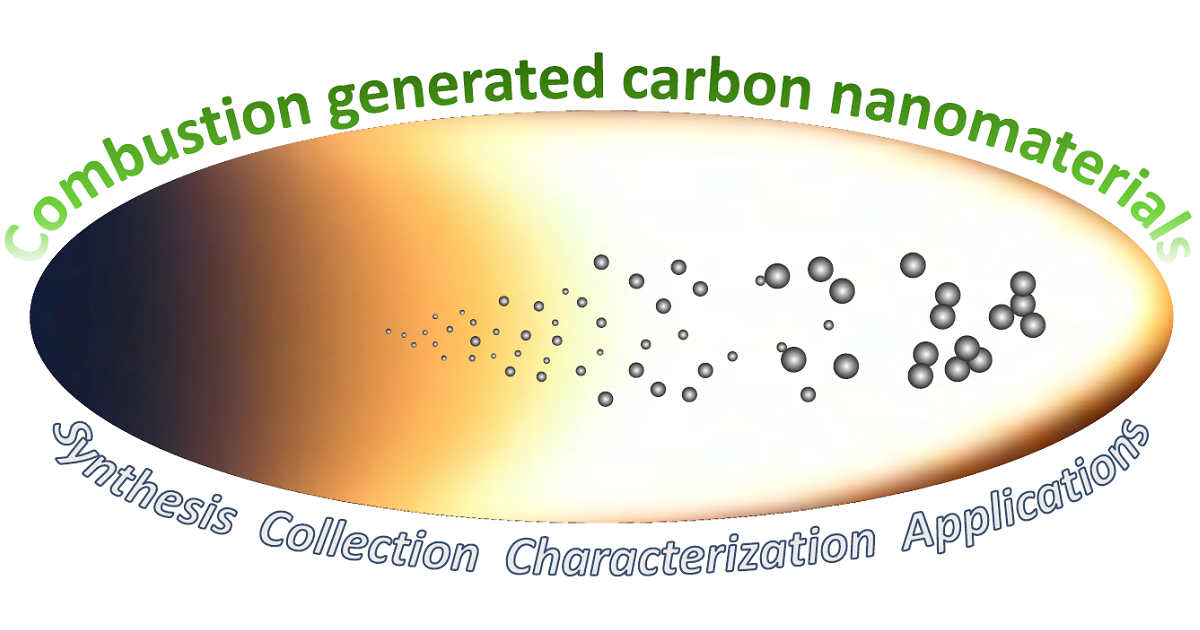Combustion Generated Carbon Nanomaterials: Synthesis, Characterization and Novel Applications
A special issue of Applied Sciences (ISSN 2076-3417). This special issue belongs to the section "Nanotechnology and Applied Nanosciences".
Deadline for manuscript submissions: closed (20 January 2023) | Viewed by 19121

Special Issue Editors
Interests: combustion processes; soot formation and oxidation; flame synthesis and characterization of oxide nanoparticles, optical diagnostic techniques; laser spectroscopy; optical characterization of soot and carbon nanoparticles; aerosols physicochemical characterization; scanning probe microscopy; Raman microscopy of carbon nanomaterials; film deposition of flame formed nanoparticles-optical and electrical characterization
Interests: soot formation in combustion processes; particle dynamics in flames; physiochemical properties of combustion aerosols; diagnostics for measurement and characterization of combustion-formed particulate matter; flame synthesis of nanostructured materials
Special Issue Information
Dear Colleagues,
Flame synthesis of carbon materials is among the oldest applied technology as demonstrated by carbon powders used in prehistoric paintings on cavewalls and in the chinese ink of ancient artworks. Combustion is hystorically the main source of the carbon blacks emploied for a wide number of applications. However, in the last decades combustion synthesis and related high temperature processes are emerging as extremely versatile methods for the synthesis of a large variety of novel carbon materials at both micro and nanoscale level.
New opportunities are being opened by the use of a catalytic support or by of low-cost precursors and even waste materials or biomass-derived renewable feedstock. Besides the advantages of being a simple single-step process, cost-effective and scalable, combustion synthesis allows controlled growth of materials with remarkable chemico-physical, optical, electronic and electrical and electrochemical proprieties that make them well-suited for a wide number of applications, from the energy harvesting and storage, generation of hydrophobic surfaces for the separation of organic pollutants in environments, or even the production of fluorescence emitters and advanced sensors.
Examples of such products include: carbon quantum dots, fullerenes, carbon nanotubes, carbon nanodisks and graphene as well as raw and functionalized flame-formed carbon nanoparticles (sometime referred to as candle soot).
This Special Issue seeks to address recent developments in combustion synthesis routes of carbon nanomaterials. Fundamental and applied studies are welcome. Papers addressing the following aspects for carbon nanomaterials produced by combustion and related processes are also welcome:
- new or improved combustion synthesis routes;
- use of novel or renewable fuel material;
- functionalization and characterization of combustion-formed carbon nanomaterials;
The carbon products can be in the form of powders, aerosols, suspended particles/nanoparticles in liquids or deposited as thin films.
Full papers, communications, and reviews covering these subjects are welcome.
Dr. Patrizia Minutolo
Dr. Mario Commodo
Guest Editors
Manuscript Submission Information
Manuscripts should be submitted online at www.mdpi.com by registering and logging in to this website. Once you are registered, click here to go to the submission form. Manuscripts can be submitted until the deadline. All submissions that pass pre-check are peer-reviewed. Accepted papers will be published continuously in the journal (as soon as accepted) and will be listed together on the special issue website. Research articles, review articles as well as short communications are invited. For planned papers, a title and short abstract (about 250 words) can be sent to the Editorial Office for assessment.
Submitted manuscripts should not have been published previously, nor be under consideration for publication elsewhere (except conference proceedings papers). All manuscripts are thoroughly refereed through a single-blind peer-review process. A guide for authors and other relevant information for submission of manuscripts is available on the Instructions for Authors page. Applied Sciences is an international peer-reviewed open access semimonthly journal published by MDPI.
Please visit the Instructions for Authors page before submitting a manuscript. The Article Processing Charge (APC) for publication in this open access journal is 2400 CHF (Swiss Francs). Submitted papers should be well formatted and use good English. Authors may use MDPI's English editing service prior to publication or during author revisions.
Keywords
- Combustion synthesis/Flames/Pyrolysis
- Carbon nanomaterials/nanoparticles
- Carbon quantum dots
- Soot/Candle soot
- Carbon black
- Carbon nanotubes/nanofibers
- Powders/aerosols
- Particle deposition/thin films
- Functional materials/Nanocomposites
- Chemical/structural characterization
- Optical characterization
- Molecular dynamics
- Chmical and electrochemical characterization
- Morphological characterization/microscopy
- Optoelectronic applications
- Energy harvesting and storage
- Sensors
- Hydrophilic/Hydrophobic surfaces and coatings
- Recycling
Benefits of Publishing in a Special Issue
- Ease of navigation: Grouping papers by topic helps scholars navigate broad scope journals more efficiently.
- Greater discoverability: Special Issues support the reach and impact of scientific research. Articles in Special Issues are more discoverable and cited more frequently.
- Expansion of research network: Special Issues facilitate connections among authors, fostering scientific collaborations.
- External promotion: Articles in Special Issues are often promoted through the journal's social media, increasing their visibility.
- Reprint: MDPI Books provides the opportunity to republish successful Special Issues in book format, both online and in print.
Further information on MDPI's Special Issue policies can be found here.






